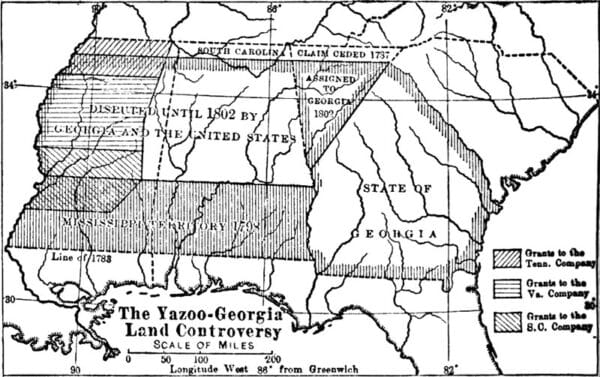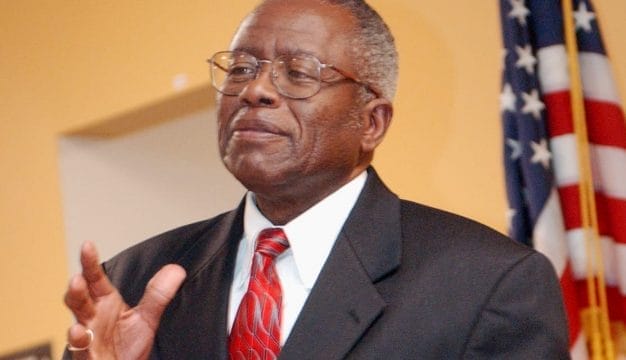Zachariah Cox
As a surveyor and land speculator, Zachariah Cox (ca. 1765-1838) played a short-lived but major role in the history of Alabama before it was even a state. In the 1780s, he was involved in attempts to settle the Muscle Shoals area on the Tennessee River and later controlled about 3.5 million acres of present-day north Alabama. Shifting political allegiances, however, led to a reversal of his fortunes by the late 1790s. Despite his brief career, Cox’s impact has endured. Precedents set by two land companies that Cox formed in 1789 and 1795 shaped Alabama’s border with Mississippi and Georgia.
 Yazoo Land Fraud Territories
Historians think Cox was born about 1765, possibly in Virginia. He is first recorded as a surveyor in 1785 records of Wilkes County, Georgia. His domain was the western land claimed by Georgia in the vast new region ceded to the United States by Britain in the 1783 Treaty of Paris, which ended the Revolutionary War. Early Tennessee leaders William Blount and John Sevier hired Cox to identify fertile parts of the Tennessee Valley area. Around 1785, Cox led a group of settlers from Wilkes County to the Muscle Shoals area of the Tennessee River. Opposition from local Indian leaders and the federal government, however, thwarted Cox and his partners.
Yazoo Land Fraud Territories
Historians think Cox was born about 1765, possibly in Virginia. He is first recorded as a surveyor in 1785 records of Wilkes County, Georgia. His domain was the western land claimed by Georgia in the vast new region ceded to the United States by Britain in the 1783 Treaty of Paris, which ended the Revolutionary War. Early Tennessee leaders William Blount and John Sevier hired Cox to identify fertile parts of the Tennessee Valley area. Around 1785, Cox led a group of settlers from Wilkes County to the Muscle Shoals area of the Tennessee River. Opposition from local Indian leaders and the federal government, however, thwarted Cox and his partners.
Undeterred, Cox returned to Georgia and in November 1789 secured an appointment as assistant clerk of the Georgia House of Representatives. This influential position provided Cox access to legislators and officials of the fledgling state, enabling him to advance his interests. In early December 1789, together with two Wilkes County partners, John Strother and Thomas Gilbert, Cox successfully petitioned the General Assembly of Georgia for permission to establish a settlement north and south of the Tennessee River.
At the time, the Georgia legislature was eagerly considering proposals to buy its western lands. Burdened with large debts from the Revolutionary War, the small coastal state was also enormously challenged by the prospect of managing its vast new western territory, which stretched to the Mississippi River. Georgia had previously failed to establish counties in the territory and had been unable to cede land to Congress, but state officials renewed their efforts. On December 21, 1789, Gov. Edward Telfair signed the Yazoo Land Act, selling 20 million acres to three land companies, including Cox’s Yazoo Tennessee Company. Cox and his partners purchased 3.5 million acres on the Tennessee River in present-day north Alabama for $55,000. Investors then bought shares in the company, entitling them to a portion of the proceeds from sales of surveyed land parcels. He published a notice inviting individuals to join his company to settle Muscle Shoals and erected a trading post and blockhouse, or small fort, there in 1791.
Cox’s plan, however, produced substantial opposition. Pres. George Washington denounced Cox for violating federal Indian land policy. William Blount, one of Cox’s early partners, was elected governor of the newly formed Southwest Territory (present-day Tennessee) and thus was obliged to enforce federal policy restricting settlement on Indian land. Blount encouraged the Cherokees to thwart Cox’s scheme. In addition, the Spanish laid claim to the area. Ultimately, Creek Indians, led by Spanish-allied agent Alexander McGillivray, drove Cox’s adventurers from the Shoals settlement. Regardless, the foundation for Georgia’s 1789 Yazoo land sales collapsed when the state insisted on being paid in gold or silver, instead of the less valuable paper currency offered by the land companies.
Although encouraged by generous bribes and corrupt promises of shares in land deals, Georgia legislators still favored selling land to resolve the state’s financial problems and western land issues. Again Cox proposed forming a land company to sell off fertile Tennessee River Valley land. Georgia’s legislature and governor approved a second Yazoo act and transferred 35 million acres in present-day Alabama and Mississippi to four land companies. Cox’s 1795 Tennessee Company purchased about 3 million acres in northern Alabama for $60,000.
Indignant Georgians, appalled by the outrageous bribery and rampant corruption, elected a new governor and legislature. In early February 1796, the new reform legislature declared the 1795 Yazoo land act “null and void,” and Cox’s enterprise collapsed. Thereafter Cox’s fortunes fell. In the late 1790s, Cox initiated new schemes—all ill-fated. After publishing a pamphlet proposing a commercial route between the Tennessee and Mobile Rivers, Cox organized a sizable expedition down the Mississippi River to develop trade connections. On August 18, 1798, however, Cox was arrested and imprisoned in Natchez on charges that he was illegally trading with Indians. Escaping to New Orleans, Cox eventually reached Nashville, where he was again arrested and jailed. Although exonerated at his Nashville trial, Cox was a beaten man and lost control of his Tennessee Company. In November 1803, Cox petitioned Congress for relief, listing his grievances for being illegally arrested by federal officials in Natchez and seeking reimbursement for his financial losses. Congress found that Cox was illegally arrested but did not award him funds to settle his claims. By 1804, Cox was living in Fauquier County, Virginia. He died there around 1838.
Cox’s 1795 Tennessee Company, though short-lived, was significant. Many early deed books of north Alabama counties show Cox as the initial owner of numerous land tracts in this region. In addition, the boundaries of the land owned by the 1795 Tennessee Company formed an important though little-recognized legacy that endures to the present. The western limit of the land holding, along the west bank of the Tennessee River between the state of Tennessee and the mouth of Bear Creek, and its eastern limit, at Tennessee’s southern boundary (between the Tennessee River and the former Chickamauga town at Nickajack Cave), are the historic basis for the west and east limits of the north boundary of the Alabama Territory in 1817, and ultimately, the state of Alabama in 1819.
Additional Resources
Dupre, Daniel S. Transforming the Cotton Frontier: Madison County, Alabama, 1800-1840. Baton Rouge: Louisiana State University Press, 1997.
Steward, Dick. Frontier Swashbuckler: The Life and Legend of John Smith T. Columbia, Missouri: University of Missouri Press, 2000.
“Memorial of Zachariah Cox” 1 November 1803, American State Papers: Miscellaneous 1: 361-362.



